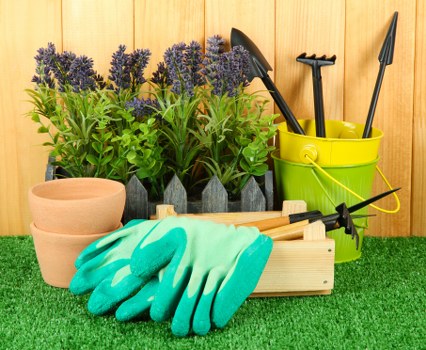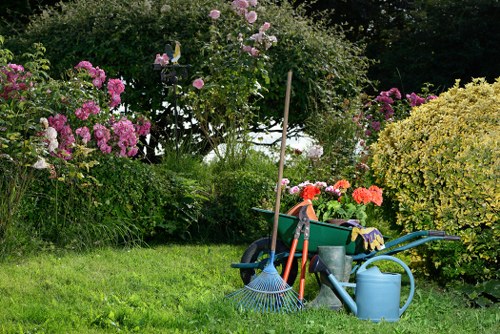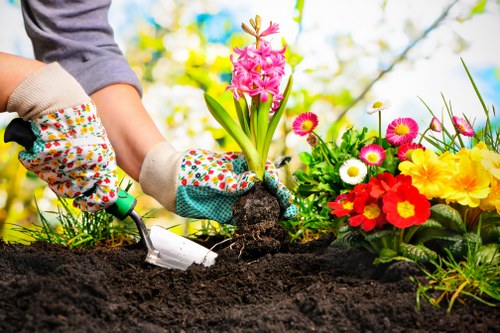Mastering Landscape Gardening: A Gardener’s Comprehensive Guide
Introduction to Landscape Gardening

Landscape gardening is an art and science that involves the planning, designing, and maintenance of outdoor spaces. For gardeners, it offers an opportunity to transform a simple garden into a breathtaking landscape that not only enhances the aesthetic appeal but also provides functional benefits such as relaxation areas, entertainment spaces, and ecological habitats.
Understanding the principles of landscape gardening is essential for creating a harmonious and sustainable environment. This guide delves into the fundamental aspects of landscape gardening, offering insights and tips for both novice and experienced gardeners.
Whether you're looking to redesign your backyard, create a themed garden, or simply improve your gardening skills, mastering landscape gardening will empower you to achieve stunning results.
Planning Your Landscape

Assessing Your Space
The first step in landscape gardening is assessing the available space. Take note of the sunlight exposure, soil type, drainage patterns, and existing vegetation. This information will guide your decisions on plant selection, layout, and garden features.
Creating a detailed map of your garden area can help visualize the layout and identify any potential challenges. Consider factors such as the slope of the land, proximity to water sources, and accessibility for maintenance.
By thoroughly assessing your space, you can ensure that your landscape design is both practical and aesthetically pleasing.
Design Principles

Balance and Proportion
Balance and proportion are key elements in landscape gardening. Symmetrical designs create a formal and orderly appearance, while asymmetrical arrangements offer a more natural and relaxed feel.
Consider the size and scale of plants, structures, and features to maintain harmony within the garden. For instance, pairing large trees with smaller shrubs can create a visually appealing contrast.
Maintaining the right proportion ensures that no single element overwhelms the rest, resulting in a cohesive and balanced landscape.
Unity and Variety
Achieving unity in your garden involves using consistent design elements such as color schemes, materials, and plant types. This creates a sense of cohesion throughout the space.
Incorporating variety adds interest and prevents the garden from appearing monotonous. Mix different textures, shapes, and colors to create focal points and visual intrigue.
Striking the right balance between unity and variety enhances the overall beauty and functionality of your landscape.
Choosing the Right Plants

Understanding Plant Hardiness
Selecting plants that are suitable for your climate and soil conditions is crucial. Consider the hardiness zones to determine which plants will thrive in your region.
Research the water requirements, growth habits, and maintenance needs of each plant to ensure they fit well within your landscape design.
Incorporating native plants can also promote sustainability, as they are adapted to the local environment and support local wildlife.
Creating Plant Groups
Grouping plants with similar needs together simplifies maintenance and promotes healthier growth. For example, cluster drought-tolerant plants in areas with limited water access.
Use layering techniques by arranging plants in tiers, from ground covers to tall shrubs and trees, to add depth and dimension to your garden.
Strategic plant grouping enhances both the functionality and visual appeal of your landscape.
Implementing Garden Structures

Paths and Walkways
Paths and walkways guide visitors through the garden, providing access to different areas. Choose materials that complement your landscape, such as stone, gravel, or wood.
Curved paths can create a sense of mystery and discovery, while straight walkways offer a more formal and structured feel.
Incorporate lighting along paths to enhance safety and highlight key features during the evening.
Water Features and Focal Points
Water features like ponds, fountains, or waterfalls add a tranquil element to your garden. The sound of flowing water can create a soothing atmosphere and attract wildlife.
Focal points such as sculptures, gazebos, or unique plant arrangements draw the eye and anchor the design.
Choose structures that align with your garden’s theme and personal preferences to make a lasting impression.
Sustainable Practices in Landscape Gardening

Water Conservation
Implementing water-efficient techniques is vital for sustainable landscaping. Use mulching to retain soil moisture and reduce evaporation.
Install drip irrigation systems that deliver water directly to the plant roots, minimizing waste and ensuring optimal hydration.
Collecting rainwater in barrels can provide a natural and free source of water for your garden.
Soil Health and Fertility
Healthy soil is the foundation of a thriving garden. Regularly test your soil to determine its pH level and nutrient content.
Add organic matter such as compost or manure to improve soil structure, fertility, and microbial activity.
Rotate crops and plant cover crops to prevent soil depletion and reduce the risk of pests and diseases.
Seasonal Landscape Gardening Tips

Spring Planting
Spring is an ideal time for planting perennial flowers, shrubs, and trees. The cooler temperatures and increased rainfall support healthy root development.
Start by pruning any dead or damaged branches from trees and shrubs to encourage new growth.
Incorporate colorful annuals to add vibrancy and attract pollinators early in the season.
Summer Maintenance
During the summer, focus on regular watering, especially for newly planted areas. Use shade cloths to protect sensitive plants from intense sunlight.
Weed control becomes crucial to prevent competition for nutrients and water.
Consider adding seasonal décor such as garden lights or outdoor furniture to enhance the usability of your garden space.
Pest and Disease Management

Identifying Common Pests
Regularly inspect your plants for signs of pests such as aphids, slugs, and beetles. Early detection allows for timely intervention.
Use natural predators like ladybugs and birds to keep pest populations in check.
Apply organic pesticides cautiously to minimize impact on beneficial insects and the environment.
Preventing Plant Diseases
Maintain good air circulation around plants by proper spacing and pruning to prevent fungal infections.
Avoid overhead watering, which can create moist conditions favorable for disease development.
Rotate crops and practice sanitation by removing diseased plant parts to reduce disease spread.
Enhancing Garden Aesthetics

Color Coordination
Choose a cohesive color palette to create a visually pleasing garden. Harmonize flower colors with foliage and structures to achieve a balanced look.
Use contrasting colors to highlight specific areas or create focal points within the landscape.
Seasonal color changes can add dynamic interest throughout the year.
Texture and Form
Incorporate a variety of textures and forms by mixing plants with different leaf shapes, sizes, and surface finishes.
Combine smooth-leaved plants with those that have coarse or variegated foliage to add depth and complexity.
Varying plant heights and structures contribute to a more engaging and layered garden design.
Lighting and Ambiance

Outdoor Lighting Options
Proper lighting extends the usability of your garden into the evening hours. Options include string lights, lanterns, pathway lights, and spotlights.
Solar-powered lights offer an energy-efficient solution, while LED fixtures provide bright and long-lasting illumination.
Strategically place lights to highlight key features and ensure safety along walkways.
Creating a Relaxing Atmosphere
Use lighting to create zones for different activities, such as dining, lounging, or entertaining. Soft, warm lighting fosters a cozy and inviting ambiance.
Incorporate elements like fire pits or outdoor heaters to enhance comfort during cooler evenings.
Sound elements such as wind chimes or water features paired with lighting can further enrich the sensory experience.
Maintaining Your Landscape

Regular Care and Upkeep
Consistent maintenance is essential for a thriving landscape. This includes watering, weeding, pruning, and fertilizing as needed.
Schedule regular inspections to identify and address any issues promptly, ensuring the long-term health of your garden.
Seasonal tasks such as leaf cleanup in the fall and mulching in the spring prepare your garden for changing weather conditions.
Tools and Equipment
Invest in quality gardening tools to make maintenance tasks more efficient and enjoyable. Essential tools include pruners, hoes, rakes, and wheelbarrows.
Properly maintain your tools by cleaning and storing them after use to extend their lifespan.
Consider ergonomic designs to reduce strain and increase comfort during extended gardening sessions.
Incorporating Technology in Landscape Gardening

Smart Irrigation Systems
Smart irrigation systems automate watering schedules based on weather conditions and soil moisture levels. This ensures optimal water usage and reduces waste.
Integrate sensors and controllers to customize watering patterns, accommodating the specific needs of different plant groups.
These systems can often be controlled remotely via smartphone apps, providing convenience and flexibility.
Garden Design Software
Utilize garden design software to create detailed plans and visualize your landscape before implementation. Features may include 3D modeling, plant databases, and customizable layouts.
Software tools can help in experimenting with different design elements and making informed decisions, saving time and resources.
They also facilitate collaboration with professional landscapers, ensuring your vision is accurately brought to life.
Conclusion: Transform Your Garden into a Masterpiece

Landscape gardening offers endless possibilities for creativity and expression. By understanding the core principles, selecting the right plants, and incorporating sustainable practices, you can create a stunning and functional outdoor space.
Continuous learning and adapting will ensure your garden remains vibrant and resilient through the seasons.
Embrace the art of landscape gardening and watch your garden flourish into a true masterpiece.



